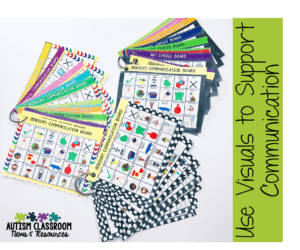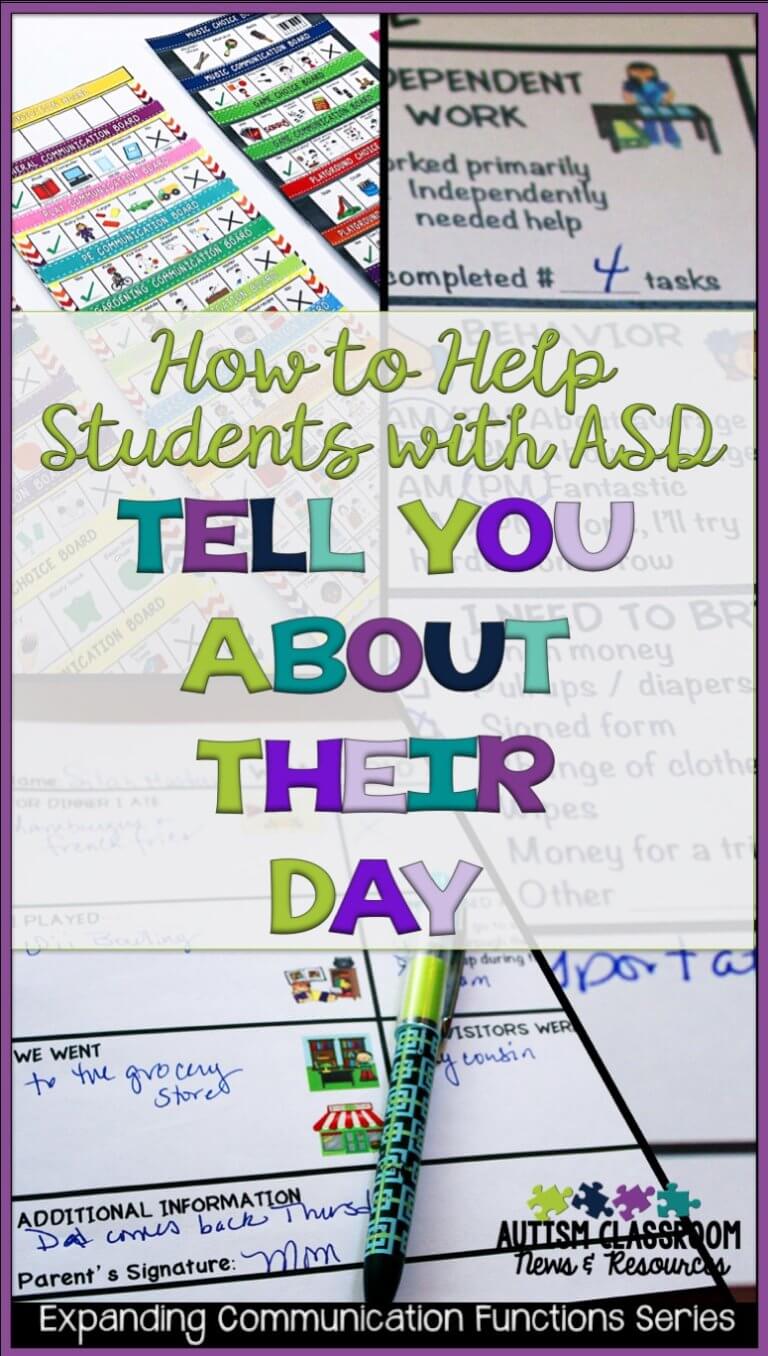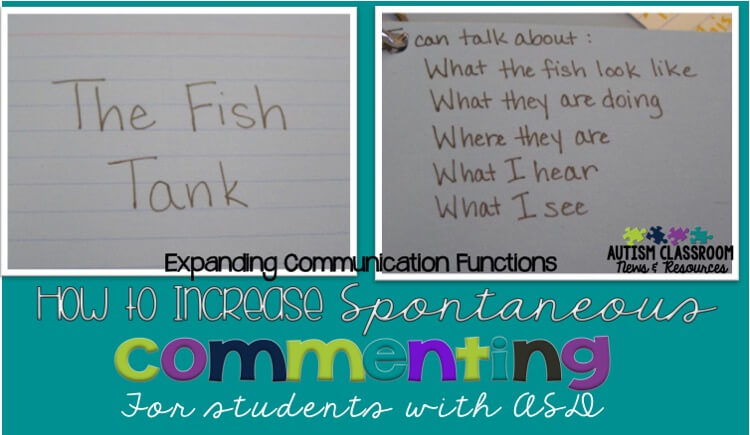It seems like our students should be able to answer questions easily when they come into our classroom. Typical preschoolers usually come to school with that skill. Much of our instruction involves answering the questions of the teachers. And yet, answering questions is not as easy or straightforward as it appears. Answering questions has a social function–we do it because someone asked us and there are social consequences. Don’t answer the question and people think you are rude. We answer the question because it’s a social obligation. Not one of our students’ strengths most of the time.
So, what do we need to know to teach our students to effectively teach our students to answer questions?
 1. Different Types of Questions
1. Different Types of Questions
Obviously we know there are different types of questions. But we don’t always realize how these different types and purposes can trip our kids up. So, we write a goal that the student will “answer questions posed by adults.” And then we teach it and take data and our data looks like the data point is on a trampoline. It’s 100% one day, 0 % the next. Sure this could be that the student is unreliable and unpredictable. More likely though, it’s that we are asking him different types of questions on different days.
So, what kind of questions are there? Many people break them down by Who, What, When, Where and Why. However, I find it easier to break them down by function of the question. For instance “What is this picture?” is a whole lot different than “What did you do last night?” Check out the video replay below and I talk more about the importance of this issue.
Here are a few of the types of questions to give you some idea of the level of difficulty involved for our kids.
- Factual questions — these are probably the easiest for our students because there is one answer. These are the kinds of questions we ask about academics most of the time. Typically they learn the answer and they can answer those. Questions asking them what a picture shows is a good example of a factual question.
- Opinion–these are much more tricky. Opinions are individual. They aren’t rote and routine. And they may change over time. Opinion questions are questions like, “Do you like sailing?” or “What team do you root for?”(These get even more interesting when students learn to ask them and don’t agree with the answer you give!). Many times when we practice opinion questions, we get the same answer over and over even when we know it doesn’t reflect the student’s interests. They learn a response and they stick to it because it’s easier than describing something.
- Relating Experiences–many times our questions are purely social and we are asking the student to tell us about what happened. “What did you do this weekend?” is probably one of the most common. I’m going to address this as a communication function in future posts. However, suffice it to say, being able to answer a factual question (“Ice cream is cold”) does not mean you can relate what happened when you went to get some ice cream. It’s a multi-step answer that involves remembering what happened, sequencing the story, accessing and using the vocabulary related to the experience, etc. In short…it’s a whole lot harder.
- Relating Feelings–again this one gets more discussion in future posts because it’s complicated. Being able to tell someone how you feel means you have to first understand your own feelings. This in itself is difficult for many of our students. It might mean talking about someone else’s feels, tapping into the difficulty our students have understanding others’ perspectives. This one can be a real quagmire for our students and they might bottom out when we as these types of questions. Beyond the simple, “How are you?” that gets an automatic answer.
- Why–Why??????? Oh Why????? Why is so very hard? Why is why hard? [sorry I just couldn’t resist] Because the answer changes. Because you have to know that something happened or have information about the topic. Then you need to relate it to the topic and explain it in a way the listener can understand.
[socialpug_tweet tweet=”Write IEP goals based on the functions of the questions you want the students w/ #autism to answer.” display_tweet=”Write IEP goals based on the functions of the questions you want the students to answer.”]
There are surely a number of other types of questions that can be asked than just those I’ve listed here. My point is that answering questions is different depending on the information the asker is seeking. So, when you write those goals, write them for specific KINDS of questions that the student is expected to answer.
![]()
For example:
- Stew Dent will answer questions about something that happened earlier in the day when given visual supports as cues on 8/10 opportunities.
- Joe Student will answer factual questions about vocabulary and academic information that he has been exposed to in the past with 85% accuracy.
- Jane will answer questions that involve making a choice and accept the choice he made (e.g., Do you want milk or juice?” The student chooses juice and accepts juice).
2. Yes / No Are Not That Easy
So many times I see that trampoline type of data when the student is learning to answer yes/no questions. Yes/no questions seem really simple to those of us with great language skills. Do I want something? I do-yes; or I don’t-no. However, imagine we used “blue” and “yellow” instead of “yes” and “no” to answer these questions.
Teacher: “Do you want milk?”
Student: “Blue”
Teacher: gives the student milk.
Student: throws the milk across the room and reaches for the juice.
We know what yes and no mean and we have known it since we were at least 2 in most cases. However, we are teaching it to our students so they don’t know the unique meaning of yes and no. To them they are just words like blue and yellow. Just like other questions, yes/no questions have different functions.
[socialpug_tweet tweet=”Factual yes/no questions are easier than opinion or choice-based yes/no questions. #autism” display_tweet=”Factual yes/no questions are easier than opinion or choice-based yes/no questions.”]
Factual yes/no questions are easier because they have the same answer each time.
Teacher: “Is this a flower?” holding a picture of a flower
Student: “Yes”
Teacher: Great job!!
Teacher: “Is this a flower?” holding a picture of a dog
Student: “No”
Teacher: “Great job”
It can sometimes be confusing for some students because the question in that scenario is the same but the answer is different (depending on what picture the teacher is holding). However, with training our students can usually learn it pretty well because they connect the word “flower” to pictures of the flower.
Factual yes/no questions are different than preference types of questions like those below.
Teacher: “Do you want a cookie?”
Student: “Yes”
Teacher: Gives him a cookie
Teacher: “Do you want spinach?”
Student” “Yes” (because he got something he liked when he said yes before)
Teacher: Gives him spinach.
Student: Screams and throws it or pushes it away.
The answer changes depending on the situation. Perhaps another time the teacher asks if he wants spinach and he does want it. If he learns the answer is always no, he might be just as frustrated when he doesn’t get it.
So, in short, remember that yes/no questions are more complicated than they seem and target them with that in mind.
![]()
Think about goals like:
- John will answer yes/no questions about factual information such as labeling items or who is the teacher with 90% accuracy.
- Sally will answer yes/no questions about immediate wants and needs (e.g., do you want milk?) and accept the item he said, “yes” to with 95% accuracy.
3. Use Visual Strategies to Cue
 Sometimes answering questions is difficult because students have difficulty accessing the vocabulary they need to answer the question. They may be able to visualize the answer but not convey it in words. Answering questions requires more steps than we typically realize, one of which is to generate the language that is not often included in the question. To address this, use visual cues to get the student started. Or if he is having difficulty with word retrieval, try adding pictures to make the task easier. Even understanding that a yes or no is required can sometimes be difficult. Think about giving choices with pictures and teaching him to refer to the picture to answer the question. So instead of “yes,” he might reply “Yes, I want a cookie.” Having a picture of the cookie or the spinach can make it easier to generate this type of statement.
Sometimes answering questions is difficult because students have difficulty accessing the vocabulary they need to answer the question. They may be able to visualize the answer but not convey it in words. Answering questions requires more steps than we typically realize, one of which is to generate the language that is not often included in the question. To address this, use visual cues to get the student started. Or if he is having difficulty with word retrieval, try adding pictures to make the task easier. Even understanding that a yes or no is required can sometimes be difficult. Think about giving choices with pictures and teaching him to refer to the picture to answer the question. So instead of “yes,” he might reply “Yes, I want a cookie.” Having a picture of the cookie or the spinach can make it easier to generate this type of statement.
If you are having the student answer academic questions, like what a character did in a story (relating information) or talk about feelings by giving them a graphic organizer and a word bank. Something as simple as a bank of vocabulary words or pictures he/she can use to answer the questions may relieve enough stress for him to be successful. Over time you can fade the visual supports out, but when initially teaching the skill, they make a useful tool.
So those are my thoughts about teaching question answering….what have you done that has worked for you? IF you want some great ideas, check out the video below from our Facebook Live session and I hope you can join us on Sunday nights at 8 PM eastern next week for more fun!
Facebook Live Video
Let’s talk about teaching students with autism to answer questions
Posted by Autism Classroom News on Sunday, January 29, 2017
Until next time,

Looking for other posts in this series…you might like these:
Expanding Communication Functions: How to Increase Description






